30.10.2022

NASA will host a media teleconference at 12 p.m. EDT Thursday, Nov. 3, to discuss the status of its Artemis I flight test that will launch the Space Launch System (SLS) rocket from NASA’s Kennedy Space Center in Florida. The uncrewed mission will send the Orion spacecraft beyond the Moon and back to Earth before future missions with crew.
Audio of the call will livestream on the agency’s website at:
Briefing participants include:
- Jim Free, associate administrator, Exploration Systems Development Mission Directorate, NASA Headquarters
- Cliff Lanham, senior vehicle operations manager, Exploration Ground Systems Program, Kennedy
To participate by telephone, media must RSVP no later than two hours before the briefing to: ksc-newsroom@mail.nasa.gov.
NASA is planning to roll the SLS rocket and Orion spacecraft to Launch Pad 39B at Kennedy Friday, Nov. 4, at 12:01 a.m. ahead of launch.
The agency continues to target launch for Monday, Nov. 14, with liftoff planned during a 69-minute launch window that opens at 12:07 a.m. EST. A launch on Nov. 14 would result in a mission duration of about 25-and-a-half days with a splashdown in the Pacific Ocean Friday, Dec. 9.
Through Artemis missions, NASA will land the first woman and the first person of color on the Moon, paving the way for a long-term lunar presence, and serving as a steppingstone to send astronauts to Mars.
Quelle: NASA
----
Update: 2.11.2022
.
NASA's Artemis 1 moon rocket 'on track' to roll out to pad Friday (Nov. 4)
The Space Launch System rocket will roll out ahead of a planned Nov. 14 launch.

NASA's Artemis 1 moon rocket will make another trip to the launch pad on Friday (Nov. 4) ahead of its historic lunar mission.
Artemis 1 is the first mission for NASA's massive Space Launch System (SLS) megarocket and the second for the Orion spacecraft capsule it will launch to lunar orbit. The rocket has been rolled back to NASA's Vehicle Assembly Building (VAB) on three previous occasions — once each in April and July following fueling tests, and again in September to shelter from Hurricane Ian.
If all goes according to plan, SLS and Orion will roll back out to Launch Pad 39B at NASA's Kennedy Space Center in Florida on Friday (Nov. 4), with the 4-mile (6.4 kilometers) journey beginning at 12:01 a.m. EDT (0401 GMT), according to a NASA blog post(opens in new tab) published Friday (Oct. 28). NASA adds that "minor repairs identified through detailed inspections are mostly completed" on the SLS rocket ahead of the next launch window.
Following the last roll back to the VAB on Sept. 26 to shelter SLS from Hurricane Ian, NASA engineers have been completing testing and repairs on the rocket. "Testing of the reaction control system on the twin solid rocket boosters, as well as the installation of the flight batteries, is complete and those components are ready for flight," NASA wrote in the blog post.
NASA adds that engineers have also replaced batteries on the rocket's interim cryogenic propulsion stage (ICPS), which was "powered up for a series of tests to ensure the stage is functioning properly." Final confidence checks were also completed on the ICPS, the rocket's second stage that will propel it and the Orion capsule toward the moon once SLS's solid rocket boosters and core stage have been jettisoned following liftoff and first-stage burn.
There are still several systems that engineers continue to work on, including replacing batteries on the rocket's core stage and upper section. Testing of the flight termination system, which is designed to destroy the SLS if something goes wrong during launch, will resume next week once the rocket is back at the pad, NASA wrote.
The agency will attempt to launch the Artemis 1 mission no earlier than Nov. 14 at 12:07 a.m. EDT (0407 GMT).
Quelle: SC
----
Update: 7.11.2022
.
NASA Sets Coverage for Artemis I Moon Mission Launch

NASA is targeting Monday, Nov. 14, for the launch of the Artemis I Moon mission during a 69-minute launch window that opens at 12:07 a.m. EST. The launch countdown will begin Saturday, Nov. 12, at 12:27 a.m.
Artemis I is the first integrated flight test of NASA’s Space Launch System (SLS) rocket, an uncrewed Orion spacecraft, and the ground systems at the agency’s Kennedy Space Center in Florida that will pave the way for a crewed test flight and future human lunar exploration as part of Artemis.
The SLS rocket and Orion spacecraft arrived Friday, Nov. 4 at about 8:30 a.m.
Live coverage of briefings and events will air on NASA Television, the NASA app, and the agency’s website at:
Engineers previously rolled the rocket back to the Vehicle Assembly Building (VAB) Sept. 26 ahead of Hurricane Ian and after waving off two previous launch attempts Aug. 29 due to a faulty temperature sensor, and Sept. 4 due to a liquid hydrogen leak at an interface between the rocket and mobile launcher. Prior to rolling back to the VAB, teams successfully repaired the leak and demonstrated updated tanking procedures. While in the VAB, teams performed standard maintenance to repair minor damage to the foam and cork on the thermal protection system and recharge or replace batteries throughout the system.
A limited number of seats inside the auditorium will be available during briefings to previously credentialed on-site journalists on a first-come, first-served basis. The deadline has passed for media accreditation for in-person coverage of this launch.
To participate by telephone, media must RSVP no later than two hours before the start of each briefing to: ksc-newsroom@mail.nasa.gov.
Media and members of the public may also ask questions on social media using #Artemis. Audio only of the briefings will be carried on the NASA “V” circuits, which may be accessed by dialing 321-867-1220, -1240 or -7135.
NASA’s media accreditation policy for virtual and on-site activities is available online. More information about media accreditation at Kennedy is available by emailing: ksc-media-accreditat@mail.nasa.gov.
Full launch coverage is as follows. All times are Eastern, all events will air live on NASA TV, and the information is subject to change. Follow NASA’s Artemis blog for updates.
Friday, Nov. 11
7 p.m.: NASA will hold a prelaunch media briefing following a mission management team meeting with the following participants:
- Mike Sarafin, Artemis mission manager, NASA Headquarters
- Charlie Blackwell-Thompson, Artemis launch director, Exploration Ground Systems Program, Kennedy
- Emily Nelson, chief flight director, NASA Johnson
- Melody Lovin, weather officer, U.S. Space Launch Delta 45
Saturday, Nov. 12
12 p.m.: NASA will hold a prelaunch media briefing on the status of the countdown with the following participants:
- Jeremy Parsons, Exploration Ground Systems Program deputy manager, NASA Kennedy
- Melody Lovin, weather officer, U.S. Space Launch Delta 45
Sunday, Nov. 13
2:30 p.m.: Coverage of tanking operations to load propellant into the SLS rocket begins, including views of the rocket and Launch Control Center and audio from a commentator.
9:30 p.m.: Coverage of launch begins in English. Coverage will continue through translunar injection and spacecraft separation, setting Orion on its path to the Moon.
11 p.m.: Coverage of launch begins in Spanish on NASA’s Spanish-language YouTube account and will continue approximately 15 minutes after liftoff. Mission coverage updates will be posted on the NASA en español social media channels.
3 a.m.: Coverage of the postlaunch news conference will follow approximately one hour after the live launch broadcast ends. Coverage start time is subject to change, based on the exact liftoff time. The postlaunch news conference will include the following participants:
- Bill Nelson, NASA administrator
- Mike Sarafin, Artemis mission manager, NASA Headquarters
- Mike Bolger, Exploration Ground Systems Program manager, Kennedy
- John Honeycutt, Space Launch System Program manager, Marshall
- Howard Hu, Orion Program manager, NASA’s Johnson Space Center
- Emily Nelson, chief flight director, Johnson
7:30 a.m.: Coverage of Orion’s first outbound trajectory burn on the way to the Moon. Coverage start time is subject to change, based on the exact liftoff time.
8:50 a.m.: Coverage of first Earth views from Orion during outbound coast to the Moon.
NASA Television coverage of additional events throughout the mission is available online.
NASA Launch Coverage in English
Briefings and launch coverage will be available on the NASA website. Coverage will include live streaming and blog updates. On-demand video recordings and photos of the launch will be available shortly after liftoff. Follow countdown coverage on NASA’s Artemis blog at:
https://blogs.nasa.gov/artemis
Live NASA TV coverage leading to launch will begin with commentary of tanking operations at 2:30 p.m. Sunday, Nov. 13, followed by launch coverage beginning at 9:30 p.m. Launch coverage will stream on the NASA website, as well as Facebook, Twitch, NASA YouTube, and in 4k on NASA’s UHD channel. For NASA TV downlink information, schedules, and links to streaming video, visit:
On launch day, a “tech feed” will be carried on the NASA TV media channel featuring views of the rocket and audio from a commentator in the Launch Control Center throughout and a single channel of mission audio beginning 15 minutes before launch.
Countdown activities with audio of the launch control commentator will be available starting at 2:30 p.m. by dialing 321-867-1220, -1240 or –7135; listeners will hear a single channel of mission audio beginning 15 minutes before launch. Full audio from the launch broadcast will begin at 9:30 p.m. and will be available by dialing 256-715-9946 with passcode 913 471 506#.
Launch also will be available on local amateur VHF radio frequency 146.940 MHz and UHF radio frequency 444.925 MHz, FM mode, heard within Brevard County on the Space Coast.
Quelle: NASA
----
Update: 13.11.2022
.
NASA: Moon rocket endured hurricane, set for 1st test flight
NASA says its moon rocket needs only minor repairs after enduring a hurricane and is on track for liftoff next week

CAPE CANAVERAL, Fla. -- NASA's moon rocket needs only minor repairs after enduring a hurricane at the pad and is on track for its first test flight next week, a top official said Friday.
“Right now, there’s nothing preventing us" from attempting a launch on Wednesday, said NASA's Jim Free, an associate administrator.
The wind never exceeded the rocket’s design limits as Hurricane Nicole swept through Kennedy Space Center on Thursday, according to Free. But he acknowledged if the launch team had known in advance that a hurricane was going to hit, they likely would have kept the rocket indoors. The rocket was moved out to the pad late last week for its $4.1 billion demo mission.
Gusts reached 100 mph (160 kph) atop the launch tower, but were not nearly as strong farther down at the rocket. Computer models indicate there should be no strength or fatigue issues from the storm, even deep inside the rocket, Free noted.
NASA had been aiming for an early Monday launch, but put it on hold for two days because of the storm.
The 322-foot (98-meter) rocket, known as SLS for Space Launch System, is the most powerful ever built by NASA. A crew capsule atop the rocket, with three test dummies on board, will shoot for the moon — the first such flight in 50 years when Apollo astronauts last visited the moon.
NASA wants to test all the systems before putting astronauts on board in 2024 for a trip around the moon.
Two previous launch attempts, in late summer, were thwarted by fuel leaks. Hurricane Ian also forced a return to the hangar at the end of September.
Artemis 1 Mission Leaders Say Go For Launch

This evening, NASA held a media event to offer an update on the latest developments for an Artemis 1 launch attempt on November 16. Jeremy Parson, EGS Program deputy manager, and Mike Sarafin, Artemis 1 mission manager presented a picture of a launch vehicle that is ready to end the 50 year hiatus of NASA exploring beyond low-Earth orbit.
Jeremy Parson began the press briefing by noting that the launch team was on consoles at 1:24 AM EDT, Nov. 14. He also said that everything going well and that the launch countdown is on schedule.
Mike Sarafin followed Parson in the briefing. He noted that there was a launch -1 day MMT meeting that lasted for 1 ½ hours and was primary focused on two specific issues caused by Nicole. The LH2 electrical connection cable and the weather striping on Orion spacecraft.
Parson began his part of the briefing by gaving an update of what has occurred since the Artemis 1 mission management team’s, or MMT’s, conference on the evening of Nov. 13.
On Nov. 13, the Artemis 1 vehicle was powered-up and a series of program specific engineering tests, or PSET’s, which is basically integrated vehicle testing. A thorough check-out of the vehicle was completed and everything is looking good. On the mobile launch platform (MLP), crews are getting panels and valves all ready for cryo loading. The sound suppression and ignition over-pressure tank filled with water. And power was brought-up on Orion, ICPS, and Core Stage and they will remain powered through launch countdown.
Going forward with what to expect tonight and tomorrow, beginning with Monday night. Crews will begin to charge all the flight batteries on the vehicle. Pressurizing the Core Stage composite over-wrap pressure vessels will be completed. There will be final walk-downs Monday night and into Tuesday morning. The launch team will conduct a series of comm. check-out’s with Orion.
For tomorrow, the schedule picks up:
12:04 PM EST, Pick-up with blast danger area clear.
1:14 PM, Air to GN2 switch-over.
2:04 PM, Clear-out launch danger area for all personnel.
2:24 PM (T-6:40), New built-in hold.
3:24 PM, Launch Director gives a go, no-go for cryo loading.
The new built-in hold is the same built-in hold that previously lasted 2:30 but with an hour added in for cryo loading concept of operations changes. This is the “Kinder Gentler Cryo Loading” concept that NASA’s cryo loading team adopted from that used by the Stennis folks in fueling-up the SLS Core Stage for its Green Run. An hour was added to do a slower, more gentle loading of cryo, beginning with 17-20 min for LH2 chill-down and followed by 32 minutes for fast-fill. Parson also said that LOX and LH2 loading now being done in parallel.
The launch window, or T 0, is at 1:04 AM Nov. 16, Wednesday and there is a 2-hour launch window.
Turning to the two issues on the Artemis 1 vehicle due to Hurricane Nicole, during the storm signals going through the electrical cable on the MLP tail service mast liquid hydrogen umbilical started having brief, or transient, issues.
At a top-level, what the launch team has been seeing with the LH2 umbilical electrical cable are measurement transients during power-up that would go out of expected ranges for a little bit when first powering-up and then come back down to nominal ranges. The Artemis 1 launch vehicle is already in a powered-up configuration with Orion, ICPS, and Core Stage, so all of these are at a normal, stable configuration. Nonetheless, the team went through the launch commit criteria that are associated with the measurements to determine criticality, redundancy, and pre-planned contingency procedures, which basically allows the team to take failures on those measurements knowing that there are redundancy on those measurements and can proceed to launch. There is redundant data coming across that interface from the rocket and spacecraft to the ground-side.
The team charged with working on the LH2 umbilical electrical cable got to work late last Sunday night to the MLP tail service mast to change-out the LH2 electrical cable and conducted a series of wring-out tests on that cable. When that didn’t seem to remedy the “momentary transient signals” issues that only occur on power-up, the ground recepticle side, located on the back of the LH2 tail service mast umbilical plate, was changed-out, followed by a series of retests. That did not resolve the issue. However, the Mission Management Team, echoing comments in the previous night’s briefing, believes that those issues do not violate a launch commit criteria.
The team working this, according to Parson, “… did a really good job wringed-out all of the data determining the risk posture, looking at all measurements going through there, where redundancy occurs, and what launch commit criteria are associated with them.” Tonight, the J8 connector on the Core Stage will be changed-out, to be followed by tests.
During today’s Mission Management Team meeting, the status of the LH2 umbilical electrical connector located at the J8 port was reviewed. The MMT when through the status of the removal and replacement and the work that was completed and any findings as a result of that; the post removal and replacements systems status checks. There are no changes in the posture as they head into the launch attempt. The launch commit criteria were reviewed and the team agreed that the as-written launch commit criteria were the appropriate posture to have heading into the next launch attempt. That’s largely because there is a lot of systems redundancy as it pertains to the signals that are needed to be verified as part of the launch commit.
The unanimous recommendation of the team was that it was in a good position to proceed with launch countdown with the measurements it has, which was based on the criticality and redundancy posture that they have. They think they have a really robust system with the number of measurements in other areas.
Asked when he might feel a sense of relief, Parsons said that the weight will be lifted from his shoulders when fast-fill of LH2 begins and doesn’t cause trouble. The work done during the cryo loading test on September 21 led to a lot of understanding of what is going on at the LH2 4” and 8” quick-disconnects that attach to the base of the launch vehicle. The cryo team is more confident that even that the loading procedures will work, that they know how to load LH2 while putting the least amount of pressure on the seals of the 4” and 8” LH2 quick-disconnects. There is a purge can around each of the quick-disconnects that is continuously flooded with helium and contains hazardous gas measurements coming through that area. Launch requirements allow for “momentary transients”, or small spike, of LH2 leakage of hydrogen to concentrations of up to 10% as LH2 pressure increases in the umbilical so long as that leak is for only a small amount of time. During the cryo tanking test, there was a momentary spike of LH2 up to a concentration of 10% when the pressure in the LH2 umbilical increased from 2 psi, but it quickly came down. That the issue didn’t last leaves Parson with a pretty good feeling that things are dialed-in.
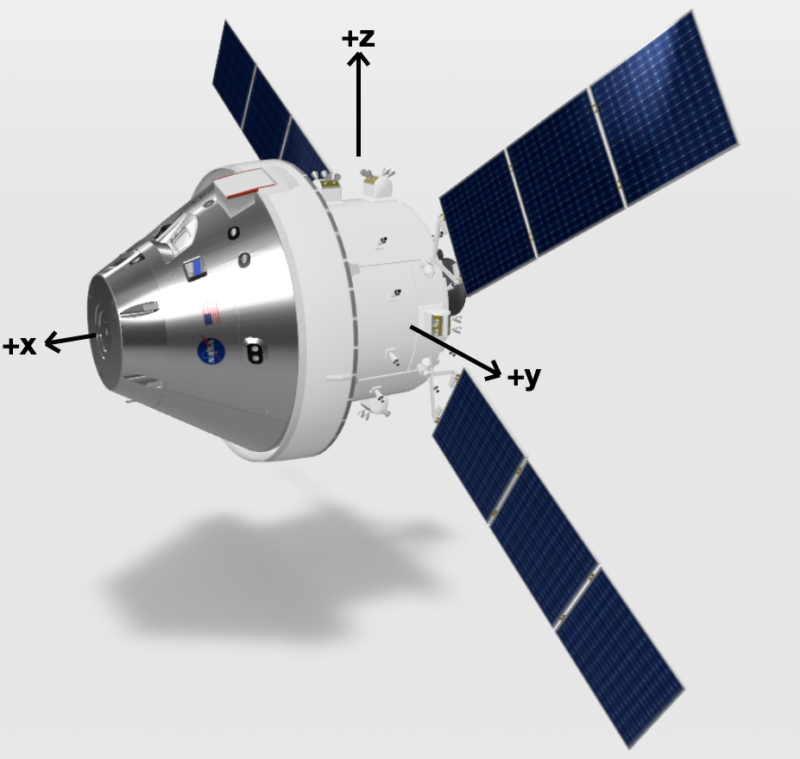
The one open action that was taken out of the launch -2 day review pertains to the Orion RTV material delaminating seen during Hurricane Nicole on the east-side of the vehicle, or roughly the 270 degree mark in the Orion coordinates, at the Orion vehicle’s aerodynamic shell, or ogive (pronounced “o-jive”), where it meets up with crew module adapter. There was a 10 foot long strip of the RTV delaminated during the storm.
The purpose of that RTV material is to fill the gap that exists between the LAS ogive and the crew module adapter. There is a small area where the two meetup where there is an aerodynamic barrier that could cause a bit of air circulation under the LAS ogive due to turbulent flow as the Artemis 1 vehicle ascends that could result in aerodynamic heating. To eliminate that small gap, the RTV material is installed to create a flush, streamlined, aerodynamic surface.
There is a small likelihood, greater than non-zero, that more RTV comes-off of the vehicle during ascent. At a top level, the “risk posture” hasn’t increased. The Mission Management team believes it has a strong flight rationale to support that point. To have an adverse event in flight, more RTV needs to come off that impacts the part of the launch vehicle, that part of the vehicle needs to experience “critical damage”, and there are limited components that could be exposed to that due the debris transport and their location to where the RTV would be liberated.
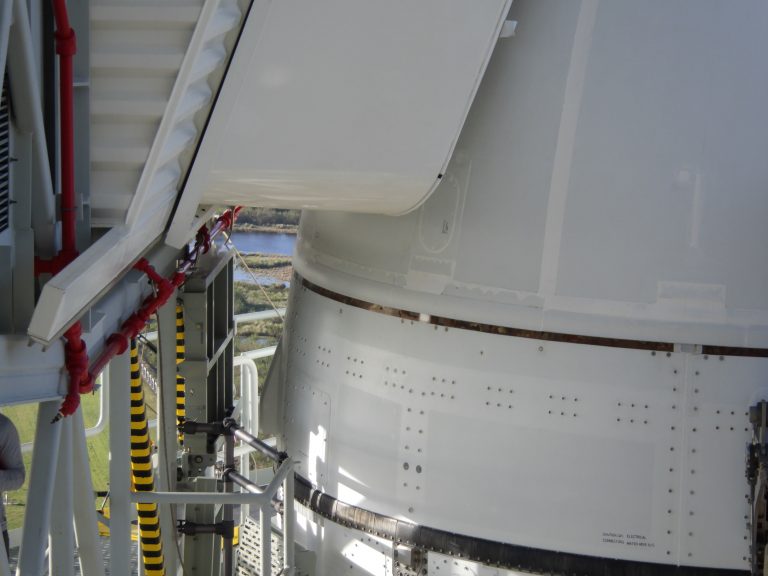
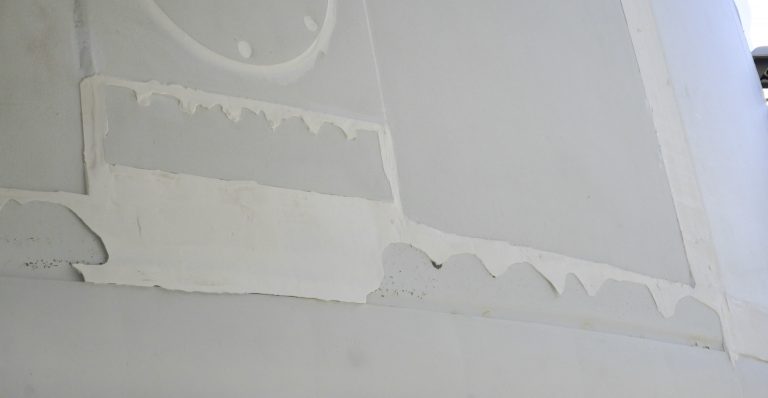
The RTV is likely to tear-off, breaking-off in smaller pieces. RTV material is very pliable and has a low-lift coefficient aerodynamically. There was a witness sample in the MMT meeting today that was 12” long. The material is very thin, light-weight, and very pliable. NASA has a lot of experience with this RTV material, which has been flown on many previous vehicle, including Exploration Test Flight 1 in 2014 and Ascent Abort Test 2 in 2019. RTV material was installed in a very similar area in those test flights and material in the interface of the LAS ogive and crew module adapter was not seen to liberate during aerodynamic flight.
The only time-frame where there is an exposure to have enough energy where the mass of any RTV that were break-off and follow a very specific trajectory and impact the vehicle downstream is in the Mach 2-3.5 range, or 80-100 seconds in flight. That is the narrow window of exposure where the rocket is accelerating fast enough but there is enough atmosphere to slow-down anything coming off the vehicle enough that there is peak impact energy.
The most likely area that RTV might impact is on the launch vehicle stage adapter, or LVSA. There were concerns about areas of the inner solid rocket boosters, the base of the boosters, and cable trays that run along both the ICPS and Core Stage.
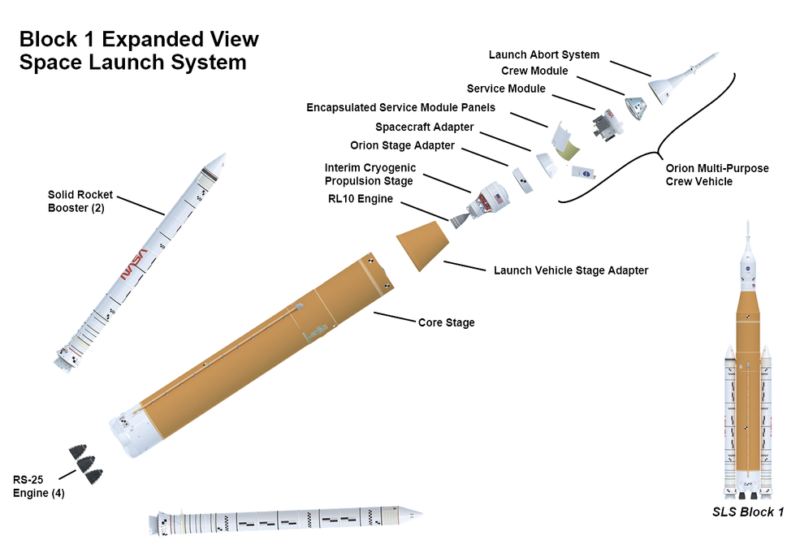
The LVSA is a tall, conical feature that sits on between the top of the SLS Core Stage and the base of the ICPS. It takes the diameter of the Orion spacecraft and extends it out to the diameter of the SLS Core Stage.
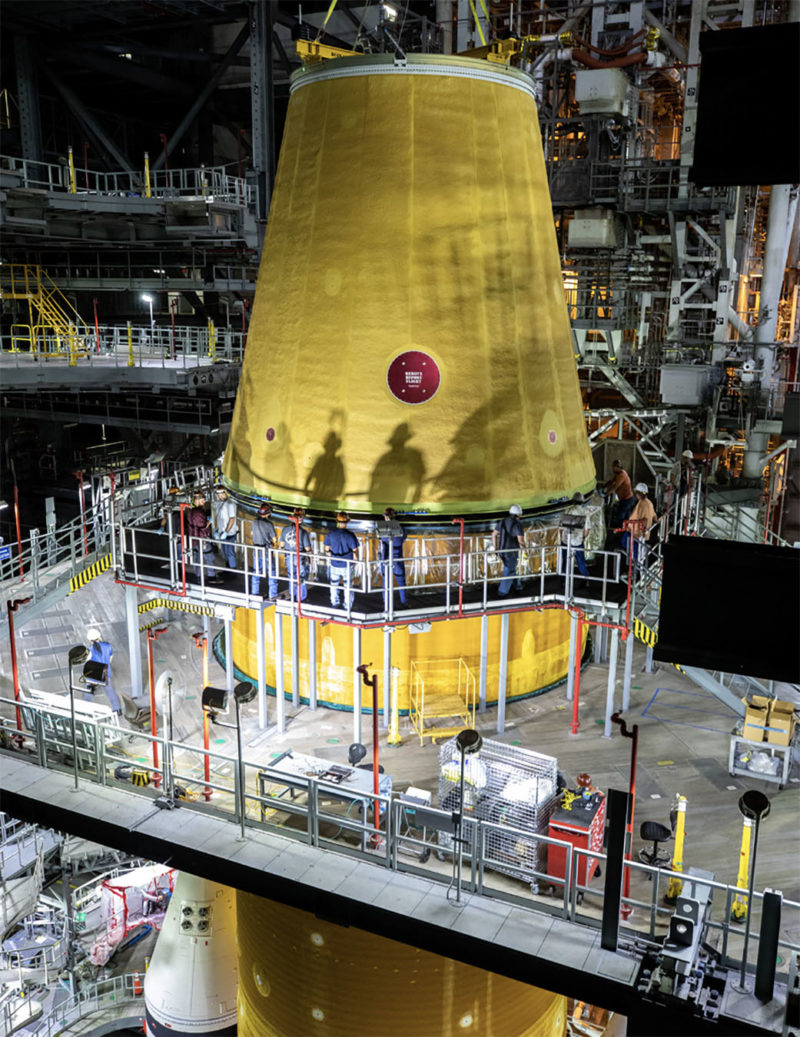
The LVSA is a very robust piece of hardware. It weighs about 10,000 lbs and is used to translate the 8.8M lb of thrust at lift-off of the boosters and Core Stage’s four RS-25’s into the ICPS, which at 45 feet weighs 71,605 lbs, and Orion spacecraft stack, which itself is 67 feet and weighs-in at 72,000 lbs. It is an inert piece of hardware–it doesn’t have fuel, avionics, or other mission critical hardware, and plays only a structural role.
An additional area that could be impacted is the inner areas of the solid boosters next to the Core Stage. The risk of this was considered moderate relative to the LVSA.
The Core Stage and the ICPS were considered low-risk. The at-risk areas for both the ICPS and Core Stage were the systems tunnels, which are small aerodynamic protrusions where cables are run for communications.
The solid rocket boosters were considered a moderate risk due to specific areas where there are separation motors at the very base of each booster.
Yesterday, when the Mission Management Team met, there was a review of the status of that delamination and the likelihood of a reoccurance during flight. The MMT decided at that time that it needed a bit more time to review the flight rationale. The launch team came back with a flight rationale based on a proven methodology termed, “The Seven Elements of Good Flight Rationale”. The MMT looked across the full vehicle stack, from the Orion spacecraft to the base of the stack, and the MMT agreed that the risk was bounded by current hazards–there are other known debris sources and hazards–and hazards reports the team had that were established well before the agency flight readiness review.
Mission Loss of Vehicle: 1/125 (0.008) may grow by greater than two decimal points due to Hurricane Nicole, however, Launch Commit Criteria (LCC’s), of which there are 489, have not changed due to the hurricane.
Mission Manager Sarafin asked the Mission Management Team members if there were any dissenting opinions, there were none, and the flight rationale of leaving the missing RTV material was accepted.
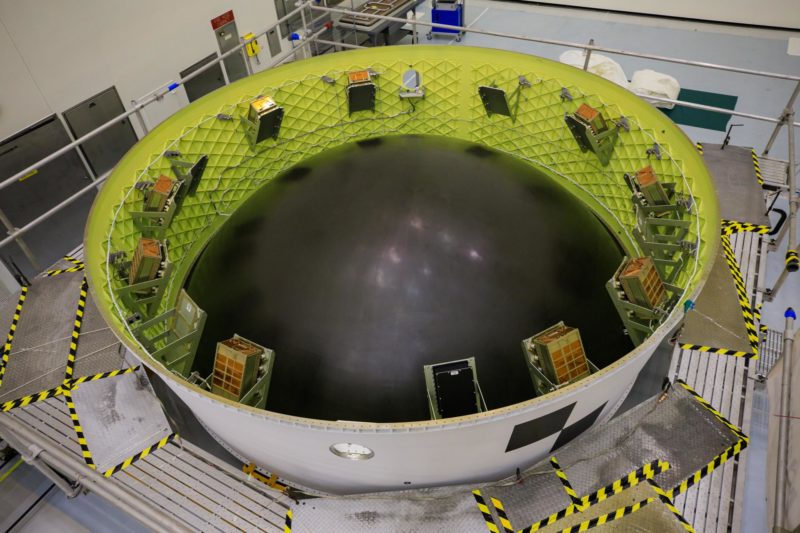
There are 10 cubesats located in the Orion Stage Adapter. 4 of the cubesats had their batteries topped-odd when the Artemis 1 vehicle was in the Vehicle Assembly Building (VAB). There is one cubesat with a science mission to map the lunar volatiles that has a low charge on its battery that may impact its ability to accomplish its mission. The remaining 5 cubesats have enough charge to last their full mission duration and accomplish their missions.
There are three manikins located in the Orion spacecraft that in terms of mass the same as an actual crew member, leaving the spacecraft one crew member light. There are mass simulators and scientific and technology demonstration payloads on the Orion spacecraft to simulate the food and other consumables, equipment, and gear that would be on a lunar mission.
Also located within the Orion spacecraft are active and passive radiation dosimeters to inform the flight environment that astronauts will experience as the Orio spacecraft leaves low-Earth orbit to deep space. As the Orion spacecraft transits from low-Earth orbit, through the Van Allen radiation belts where there are concentrations of areas of deep space radiation, and into deep space where there is no shelter from deep space radiation such as that provided by the Van Allen radiation belts. The Orion spacecraft will then upon return transit through the Van Allen radiation belts before rendering the Earth’s atmosphere and splashing-down.
One last payload is the zero-G indicator, Astro Snoopy, in partnership with the Schultz Foundation, who have been staunch advocates of the nation’s space program. The Silver Snoopy is awarded for flight safety.
Tidbit: The Orion spacecraft mass will go from 72,000 lbs on launch to 58,000 upon LAS jettison, to 12,000 lbs on splashdown.
The MMT is proceeding to the next decision gate to set-up for the Nov. 16 launch attempt and there is no change to attempt the Artemis 1 launch at that date. The MMT is comfortable launching with the known issues.
There are three buckets of criteria that could change a launch attempt from go to no-go. There are the launch commit criteria that are the 489 LCC technical must-meet criteria, weather criteria, and range safety criteria.
The next decision gate for the Mission Management Team occurs on Nov. 15 at 2:30 EST with the beginning of tanking of LH2 and LOX.
Quelle: AS
